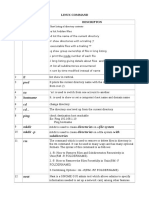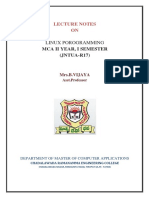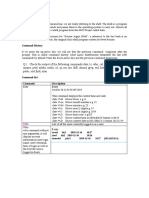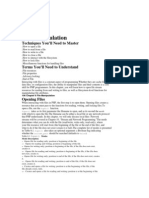0 ratings0% found this document useful (0 votes)
1K views+100 Linux Commands
This document lists over 100 essential Linux commands organized into categories including file operations, directory operations, process operations, file permissions, networking, archives and compression, text processing, disk usage, system info, package installations, shell scripting, version control, environment variables, job scheduling, Python package management, system monitoring, searching and finding files, and compression/archives. The commands provided cover basic and advanced tasks for working with files, directories, processes, networking, packages, and more on Linux systems.
Uploaded by
khushivanshCopyright
© © All Rights Reserved
Available Formats
Download as PDF, TXT or read online on Scribd
0 ratings0% found this document useful (0 votes)
1K views+100 Linux Commands
This document lists over 100 essential Linux commands organized into categories including file operations, directory operations, process operations, file permissions, networking, archives and compression, text processing, disk usage, system info, package installations, shell scripting, version control, environment variables, job scheduling, Python package management, system monitoring, searching and finding files, and compression/archives. The commands provided cover basic and advanced tasks for working with files, directories, processes, networking, packages, and more on Linux systems.
Uploaded by
khushivanshCopyright
© © All Rights Reserved
Available Formats
Download as PDF, TXT or read online on Scribd
You are on page 1/ 8
#_ Essential Linux Commands [+100 ]
1. File Operations:
● ls: Lists all files and directories in the present working
directory
● ls -R: Lists files in sub-directories as well
● ls -a: Shows hidden files
● ls -al: Lists files and directories with detailed information like
permissions, size, owner, etc.
● cd directoryname: Changes the directory
● cd ..: Moves one level up
● pwd: Displays the present working directory
● cat > filename: Creates a new file
● cat filename: Displays the file content
● cat file1 file2 > file3: Joins two files (file1 and file2) and stores
the output in a new file (file3)
● touch filename: Creates or modifies a file
● rm filename: Deletes a file
● cp source destination: Copies files from the source path to the
destination path
● mv source destination: Moves files from the source path to the
destination path
● find / -name filename: Finds a file or a directory by its name
starting from root
● file filename: Determines the file type
● less filename: Views the file content page by page
● head filename: Views the first ten lines of a file
● tail filename: Views the last ten lines of a file
● lsof: Shows which files are opened by which process.
● du -h --max-depth=1: Shows the size of each directory. Use
--max-depth=1 to limit the output to the current directory and its
immediate children.
● fdisk: Disk partition manipulation command.
By: Waleed Mousa
2. Directory Operations:
● mkdir directoryname: Creates a new directory in the present
working directory
● rmdir directoryname: Deletes a directory
● cp -r source destination: Copies directories recursively
● mv olddir newdir: Renames directories
● find / -type d -name directoryname: Finds a directory starting from
root
3. Process Operations:
● ps: Displays your currently active processes
● top: Displays all running processes
● kill pid: Kills the process with given pid
● pkill name: Kills the process with the given name
● bg: Resumes suspended jobs without bringing them to foreground
● fg: Brings the most recent job to foreground
● fg n: Brings job n to the foreground
● renice +n [pid]: Change the priority of a running process.
● &>filename: Redirects both the stdout and the stderr to the file
filename.
● 1>filename: Redirect the stdout to file filename.
● 2>filename: Redirect stderr to file filename.
4. File Permissions:
● chmod octal filename: Change the permissions of file to octal,
which can be between 0 (no permissions) to 7 (full permissions)
● chown ownername filename: Change file owner
● chgrp groupname filename: Change group owner
By: Waleed Mousa
5. Networking:
● ping host: Ping a host and outputs results
● whois domain: Get whois information for domain
● dig domain: Get DNS information for domain
● netstat -pnltu: Display various network related information such
as network connections, routing tables, interface statistics etc.
● ifconfig: Displays IP addresses of all network interfaces
● ssh user@host: Remote login into the host as user
● scp: Transfers files between hosts over ssh
● wget url: Download files from the web
● curl url: Sends a request to a URL and returns the response
● traceroute domain: Prints the route that a packet takes to reach
the domain.
● mtr domain: mtr combines the functionality of the traceroute and
ping programs in a single network diagnostic tool.
● ss: Another utility to investigate sockets. It's a more modern
alternative to netstat.
● nmap: Network exploration tool and security scanner.
6. Archives and Compression:
● tar cf file.tar files: Create a tar named file.tar containing files
● tar xf file.tar: Extract the files from file.tar
● gzip file: Compresses file and renames it to file.gz
● gzip -d file.gz: Decompresses file.gz back to file
● zip -r file.zip files: Create a zip archive named file.zip
● unzip file.zip: Extract the contents of a zip file
7. Text Processing:
● grep pattern files: Search for pattern in files
● grep -r pattern dir: Search recursively for pattern in dir
By: Waleed Mousa
● command | grep pattern: Pipe the output of command to grep for
searching
● echo 'text': Prints text
● sed 's/string1/string2/g' filename: Replaces string1 with string2
in filename
● diff file1 file2: Compares two files and shows the differences
● wc filename: Count lines, words, and characters in a file
● awk: A versatile programming language for working on files.
● sed -i 's/string1/string2/g' filename: Replace string1 with string2
in filename. The -i option edits the file in-place.
● cut -d':' -f1 /etc/passwd: Cut out the first field of each line in
/etc/passwd, using colon as a field delimiter.
8. Disk Usage:
● df: Shows disk usage
● du: Shows directory space usage
● free: Show memory and swap usage
● whereis app: Show possible locations of app
9. System Info:
● date: Show the current date and time
● cal: Show this month's calendar
● uptime: Show current uptime
● w: Display who is online
● whoami: Who you are logged in as
● uname -a: Show kernel information
● df -h: Disk usage in human readable format
● du -sh: Disk usage of current directory in human readable format
● free -m: Show free and used memory in MB
By: Waleed Mousa
10. Package Installations:
● sudo apt-get update: Updates package lists for upgrades
● sudo apt-get upgrade: Upgrades all upgradable packages
● sudo apt-get install pkgname: Install pkgname
● sudo apt-get remove pkgname: Removes pkgname
11. Others (mostly used in scripts):
● command1 ; command2: Run command1 and then command2
● command1 && command2: Run command2 if command1 is successful
● command1 || command2: Run command2 if command1 is not successful
● command &: Run command in background
12. Version Control (Git commands):
● git init: Initialize a local git repository
● git clone url: Create a local copy of a remote repository
● git add filename: Add a file to the staging area
● git commit -m "Commit message": Commit changes with a message
● git status: Check the status of the working directory
● git pull: Pull latest changes from the remote repository
● git push: Push changes to the remote repository
● git branch: List all local branches
● git branch branchname: Create a new branch
● git checkout branchname: Switch to a branch
● git merge branchname: Merge a branch into the active branch
● git stash: Stash changes in a dirty working directory
● git stash apply: Apply changes from a stash
● git log: View commit history
● git reset: Reset your HEAD pointer to a previous commit
● git rm filename: Remove a file from version control
● git rebase: Reapply commits on top of another base tip.
By: Waleed Mousa
● git revert: Create a new commit that undoes all of the changes
made in a particular commit, then apply it to the current branch.
● git cherry-pick commitID: Apply the changes introduced by some
existing commits.
13. Environment Variables:
● env: Display all environment variables
● echo $VARIABLE: Display the value of an environment variable
● export VARIABLE=value: Set the value of an environment variable
● alias new_command='old_command options': Create a new command that
executes the old command with the specified options.
● echo $PATH: Print the PATH environment variable.
● export PATH=$PATH:/new/path: Add /new/path to the PATH.
14. Job Scheduling (Cron Jobs):
● crontab -l: List all your cron jobs
● crontab -e: Edit your cron jobs
● crontab -r: Remove all your cron jobs
● crontab -v: Display the last time you edited your cron jobs
● crontab file: Install a cron job from a file
● @reboot command: Schedule a job to run at startup
15. Package Installations (using pip, a Python package installer):
● pip install packagename: Install a Python package.
● pip uninstall packagename: Uninstall a Python package.
● pip freeze > requirements.txt: Freeze the installed packages into
a requirements file.
● pip install -r requirements.txt: Install packages from a
requirements file.
By: Waleed Mousa
16. Shell Scripting:
● #!/bin/bash: Shebang line to specify the script interpreter.
● $0, $1, ..., $9, ${10}, ${11}: Script arguments.
● if [condition]; then ... fi: if statement in bash scripts.
● for i in {1..10}; do ... done: for loop in bash scripts.
● while [condition]; do ... done: while loop in bash scripts.
● function name() {...}: Define a function.
17. System Monitoring and Performance:
● iostat: Reports Central Processing Unit (CPU) statistics and
input/output statistics for devices, partitions, and network
filesystems.
● vmstat: Reports information about processes, memory, paging, block
IO, traps, disks, and CPU activity.
● htop: An interactive process viewer for Unix systems. It's a more
user-friendly alternative to top.
10. Search and Find:
● locate filename: Find a file by its name. The database updated by
updatedb command.
● whereis programname: Locate the binary, source, and manual page
files for a command.
● which commandname: Shows the full path of (shell) commands.
11. Compression / Archives:
● tar -cvf archive.tar dirname/: Create a tar archive.
● tar -xvf archive.tar: Extract a tar archive.
● tar -jcvf archive.tar.bz2 dirname/: Create a compressed bz2
archive.
● tar -jxvf archive.tar.bz2: Extract a bz2 archive.
By: Waleed Mousa
12. Disk Usage:
● dd if=/dev/zero of=/tmp/output.img bs=8k count=256k: Create a file
of a certain size for testing disk speed.
● hdparm -Tt /dev/sda: Measure the read speed of your hard drive.
13. Others:
● yes > /dev/null &: Use this command to push a system to its limit.
● :(){ :|:& };:: A fork bomb – handle with care. Do not run this
command on a production system.
Remember, you can always use the man command (e.g. man ls) to get more
information about each command.
By: Waleed Mousa
You might also like
- # - Essential Linux Commands (+100) - 168747474166950% (2)# - Essential Linux Commands (+100) - 16874747416698 pages
- Basic Linux Commands: Mkdir - Make DirectoriesNo ratings yetBasic Linux Commands: Mkdir - Make Directories5 pages
- Comprehensive Exploration of Linux CommandsNo ratings yetComprehensive Exploration of Linux Commands7 pages
- Linux Scenario Based Interviews QuestionsNo ratings yetLinux Scenario Based Interviews Questions19 pages
- Red Hat Enterprise Linux 8 - RHCSA SyllabusNo ratings yetRed Hat Enterprise Linux 8 - RHCSA Syllabus5 pages
- TCSH Scripting: Basic - A. Basic - B. Intermediate - C. D. Resources 1No ratings yetTCSH Scripting: Basic - A. Basic - B. Intermediate - C. D. Resources 12 pages
- Nehra Classes Bash Shell Scripting Syllabus100% (1)Nehra Classes Bash Shell Scripting Syllabus4 pages
- An A-Z Index of Commands: Windows PowershellNo ratings yetAn A-Z Index of Commands: Windows Powershell8 pages
- Dns-Zone-Transfer:: Scripting Engine Notable ScriptsNo ratings yetDns-Zone-Transfer:: Scripting Engine Notable Scripts2 pages
- A Complete Guide To Usage of USERMOD and USERADD Command PDFNo ratings yetA Complete Guide To Usage of USERMOD and USERADD Command PDF14 pages
- Linux Test Command Information and ExamplesNo ratings yetLinux Test Command Information and Examples4 pages
- Linux Essential Operations - CheatSheetNo ratings yetLinux Essential Operations - CheatSheet9 pages
- Non-Stationary Time Series and Unit Root Tests: Deterministic TrendNo ratings yetNon-Stationary Time Series and Unit Root Tests: Deterministic Trend13 pages
- TclVivado Byu-Cpe - BYU-Computing-Tutorials WikiNo ratings yetTclVivado Byu-Cpe - BYU-Computing-Tutorials Wiki10 pages
- File Manipulation: Techniques You'll Need To MasterNo ratings yetFile Manipulation: Techniques You'll Need To Master6 pages
- IB Eassessment ErrorProtocol 20231213100224 ZWLKQY3vNo ratings yetIB Eassessment ErrorProtocol 20231213100224 ZWLKQY3v9 pages
- How To Generate Debug Log Files For Oracle Quoting R12 (ID 430265.1)No ratings yetHow To Generate Debug Log Files For Oracle Quoting R12 (ID 430265.1)2 pages
- Slide 15 - Instructions -InT 21h InterruptsNo ratings yetSlide 15 - Instructions -InT 21h Interrupts9 pages
- XXCopy Alphabetical Command Line Syntax List100% (2)XXCopy Alphabetical Command Line Syntax List16 pages
- User Manual Quickhash-GUI-Windows-v3.3.4 para Hashear ArchivosNo ratings yetUser Manual Quickhash-GUI-Windows-v3.3.4 para Hashear Archivos38 pages
- The Little Handbook of Windows Forensics: Just Some Random Thoughts About Windows Forensics 1st Edition Andrea Fortuna 2024 Scribd Download100% (3)The Little Handbook of Windows Forensics: Just Some Random Thoughts About Windows Forensics 1st Edition Andrea Fortuna 2024 Scribd Download65 pages
- 02 Best Practices For File Naming Opt (Howto) PDF100% (1)02 Best Practices For File Naming Opt (Howto) PDF8 pages
- # - Essential Linux Commands (+100) - 1687474741669# - Essential Linux Commands (+100) - 1687474741669
- TCSH Scripting: Basic - A. Basic - B. Intermediate - C. D. Resources 1TCSH Scripting: Basic - A. Basic - B. Intermediate - C. D. Resources 1
- Dns-Zone-Transfer:: Scripting Engine Notable ScriptsDns-Zone-Transfer:: Scripting Engine Notable Scripts
- A Complete Guide To Usage of USERMOD and USERADD Command PDFA Complete Guide To Usage of USERMOD and USERADD Command PDF
- Non-Stationary Time Series and Unit Root Tests: Deterministic TrendNon-Stationary Time Series and Unit Root Tests: Deterministic Trend
- File Manipulation: Techniques You'll Need To MasterFile Manipulation: Techniques You'll Need To Master
- IB Eassessment ErrorProtocol 20231213100224 ZWLKQY3vIB Eassessment ErrorProtocol 20231213100224 ZWLKQY3v
- How To Generate Debug Log Files For Oracle Quoting R12 (ID 430265.1)How To Generate Debug Log Files For Oracle Quoting R12 (ID 430265.1)
- User Manual Quickhash-GUI-Windows-v3.3.4 para Hashear ArchivosUser Manual Quickhash-GUI-Windows-v3.3.4 para Hashear Archivos
- The Little Handbook of Windows Forensics: Just Some Random Thoughts About Windows Forensics 1st Edition Andrea Fortuna 2024 Scribd DownloadThe Little Handbook of Windows Forensics: Just Some Random Thoughts About Windows Forensics 1st Edition Andrea Fortuna 2024 Scribd Download




































































































